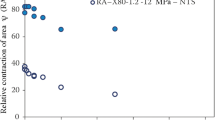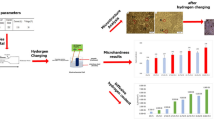Abstract
The derived diagram defines three main ranges of hydrogen concentration in the metal, which have their own specific mechanisms of hydrogen influence on the characteristics of strength and ductility of the pipeline steel. It has been demonstrated that the nature of the hydrogen effect mechanism depends on the ratio of diffusible \(C_{{{\text{H}}\left( {{\text{dif}}} \right)}}\) and residual (trapped) hydrogen \(C_{{{\text{H}}\left( {{\text{res}}} \right)}}\) in the steel. A specific effect has been found, namely: at the hydrogen concentration \(C_{{\text{H}}} \cong 0.01{\text{-}}0.2\;{\text{ppm}}\) where all hydrogen is practically diffusible, the plastic deformation of the steel is facilitated, i.e., the deforming of the material takes place more easily. At the concentration range \(C_{{\text{H}}} \cong 0.8{\text{-}}10\;{\text{ppm}}\), where the trapped hydrogen prevails, the mechanism of hydrogen embrittlement of the steel is completely dominated. Therefore, the hydrogen concentration range beginning from \(C_{{\text{H}}} \cong 0.8\;{\text{ppm}}\) can be considered as critical. The range of values of hydrogen concentration in the metal \(C_{{\text{H}}} \cong 0.2{\text{-}}0.8\;{\text{ppm}}\) is a transition zone where the simultaneous coexistence of these two mechanisms is possible. The constructed diagram can be applied for the interpretation of the inspection results of long-term operated pipelines, and also for the choice of materials for the construction of new networks for hydrogen transportation.












Similar content being viewed by others
References
G. Mulder, J. Hetland, and G. Lenaers, Towards a Sustainable Hydrogen Economy: Hydrogen Pathways and Infrastructure, Int. J. Hydrog. Energy, 2007, 32, p 1324-1331. https://doi.org/10.1016/j.ijhydene.2006.10.012
I. Dincer and C. Acar, Review and Evaluation of Hydrogen Production Methods for Better Sustainability, Int. J. Hydrog. Energy, 2014, 40, p 11094-11111. https://doi.org/10.1016/j.ijhydene.2014.12.035
F. Sorgulu and I. Dincer, A Renewable Source Based Hydrogen Energy System for Residential Applications, Int. J. Hydrog. Energy, 2018, 43, p 5842-5851. https://doi.org/10.1016/j.ijhydene.2017.10.101
P. Nikolaidis and A. Poullikkas, A Comparative Overview of Hydrogen Production Processes, Renew. Sustain. Energy Rev., 2017, 67, p 597-611. https://doi.org/10.1016/j.rser.2016.09.044
S. Sharma and S.K. Ghoshal, Hydrogen the Future Transportation Fuel: From Production to Applications, Renew. Sustain. Energy Rev., 2015, 43, p 1151-1158. https://doi.org/10.1016/j.rser.2014.11.093
J. Kurtz, S. Sprik, and T.H. Bradley, Review of Transportation Hydrogen Infrastructure Performance and Reliability, Int. J. Hydrog. Energy, 2019, 44, p 12010-12023. https://doi.org/10.1016/j.ijhydene.2019.03.027
J. Capelle, J. Gilgert, I. Dmytrakh, and G. Pluvinage, Sensitivity of Pipelines with Steel API X52 to Hydrogen Embrittlement, Int. J. Hydrog. Energy, 2008, 33, p 7630-7641. https://doi.org/10.1016/j.ijhydene.2008.09.020
G. Pluvinage, Mechanical Properties of a Wide Range of Pipe Steels Under Influence of Pure Hydrogen or Hydrogen Blended with Natural Gas, Int. J. Press. Vessel. Pip., 2021, 190, p 104293. https://doi.org/10.1016/j.ijpvp.2020.104293
G. Pluvinage, J. Capelle, and M.H. Meliani, Pipe Networks Transporting Hydrogen Pure or Blended with Natural Gas, Design and Maintenance, Eng. Fail. Anal., 2019, 106, p 104164. https://doi.org/10.1016/j.engfailanal.2019.104164
G. Pluvinage and J. Capelle, Design and maintenance of pipe networks transporting hydrogen pure or blended with natural gas, Pipeline Sci. Technol., 2019, 3, p 30-45. https://doi.org/10.28999/2514-541x-2019-3-1-30-45
ASME B13.12-2019 Hydrogen Piping and Pipelines, ASME, 2020.
C.S. Marchi, B.P. Somerday, K.A. Nibur, D.G. Stalheim, T. Boggess, S. Jansto, Fracture and fatigue of commercial grade api pipeline steels in gaseous hydrogen, In: American Society of Mechanical Engineers, Pressure Vessels and Piping Division, 2010: pp. 939-948. https://doi.org/10.1115/PVP2010-25825
B.P. Somerday and P. Sofronis, International Hydrogen Conference (IHC 2012), ASME Press, 2014. https://doi.org/10.1115/1.860298
Z.F. Chen, W.P. Chu, H.J. Wang, Y. Li, W. Wang, W.M. Meng, and Y.X. Li, Structural Integrity Assessment of Hydrogen-Mixed Natural Gas Pipelines Based on a New Multi-Parameter Failure Criterion, Ocean Eng., 2022, 247, p 110731. https://doi.org/10.1016/j.oceaneng.2022.110731
Z. Chen, Y. Chen, W. Wang, K. Lu, H. Yang, and W. Zhu, Failure Pressure Analysis of Hydrogen Storage Pipeline Under Low Temperature and High Pressure, Int. J. Hydrog. Energy, 2020, 45, p 23142-23150. https://doi.org/10.1016/j.ijhydene.2020.06.129
B. Keshtegar and M.E.A.B. Seghier, Modified Response Surface Method Basis Harmony Search to Predict the Burst Pressure of Corroded Pipelines, Eng. Fail. Anal., 2018, 89, p 177-199. https://doi.org/10.1016/j.engfailanal.2018.02.016
Z. Hafsi, S. Elaoud, and M. Mishra, A Computational Modelling of Natural Gas Flow in Looped Network: Effect of Upstream Hydrogen Injection on the Structural Integrity of Gas Pipelines, J. Nat. Gas Sci. Eng., 2019, 64, p 107-117. https://doi.org/10.1016/j.jngse.2019.01.021
B. Ozdirik, K. Baert, T. Depover, J. Vereecken, K. Verbeken, H. Terryn, and I. De Graeve, Development of an Electrochemical Procedure for Monitoring Hydrogen Sorption/Desorption in Steel, J. Electrochem. Soc., 2017, 164, p C747-C757. https://doi.org/10.1149/2.0521713jes
M. Xie and Z. Tian, A Review on Pipeline Integrity Management Utilizing In-Line Inspection Data, Eng. Fail. Anal., 2018, 92, p 222-239. https://doi.org/10.1016/j.engfailanal.2018.05.010
F. Caleyo, L. Alfonso, J.H. Espina-Hernández, and J.M. Hallen, Criteria for Performance Assessment and Calibration of in-Line Inspections of Oil and Gas Pipelines, Meas. Sci. Technol., 2007, 18, p 1787-1799. https://doi.org/10.1088/0957-0233/18/7/001
O. Barrera, D. Bombac, Y. Chen, T.D. Daff, E. Galindo-Nava, P. Gong, D. Haley, R. Horton, I. Katzarov, J.R. Kermode, C. Liverani, M. Stopher, and F. Sweeney, Understanding and Mitigating Hydrogen Embrittlement of Steels: A Review of Experimental, Modelling and Design Progress from Atomistic to Continuum, J. Mater. Sci., 2018, 53, p 6251-6290. https://doi.org/10.1007/s10853-017-1978-5
Y. Murakami, T. Kanezaki, and Y. Mine, Hydrogen Effect Against Hydrogen Embrittlement, Metall, Mater. Trans. A Phys. Metall. Mater. Sci., 2010, 41, p 2548-2562. https://doi.org/10.1007/s11661-010-0275-6
I.M. Dmytrakh, R.L. Leshchak, and A.M. Syrotyuk, Effect of Hydrogen Concentration on Strain Behaviour of Pipeline Steel, Int. J. Hydrog. Energy, 2015, 40, p 4011-4018. https://doi.org/10.1016/j.ijhydene.2015.01.094
I. Dmytrakh, A. Syrotyuk, and R. Leshchak, Specific Mechanism of Hydrogen Influence on Deformability and Fracture of Low-Alloyed Pipeline Steel, Proc. Struct. Integr., 2022, 36, p 298-305. https://doi.org/10.1016/j.prostr.2022.01.038
LECO DH603. Manual, LECO Corporation, 2019
ZEISS, Scanning Electron Microscope ZEISS SIGMA 300, Carl Zeiss SMT Ltd, Cambridge (England), n.d. https://zeiss-solutions.ru/en/equipment/mikroskopiya/electron-microscopy/zeiss-sigma-300-scanning-electron-microscope/
R.Y. Kosarevych, O.Z. Student, L.M. Svirs’ka, B.P. Rusyn, and H.M. Nykyforchyn, Computer Analysis of Characteristic Elements of Fractographic Images, Mater. Sci., 2013, 48, p 474-481. https://doi.org/10.1007/s11003-013-9527-0
R.J. Kosarevych, B.P. Rusyn, V.V. Korniy, and T.I. Kerod, Image Segmentation Based on the Evaluation of the Tendency of Image Elements to form Clusters with the Help of Point Field Characteristics, Cybern. Syst. Anal., 2015, 51, p 704-713. https://doi.org/10.1007/s10559-015-9762-5
Laue method. in Dictionary of Gems and Gemology, ed. by Manutchehr-Danai M., (Springer, Berlin, Heidelberg 2009). https://doi.org/10.1007/978-3-540-72816-0_12847
S.P. Lynch, Mechanisms of hydrogen assisted cracking: a review, in: R.H.J. N.R. Moody, A.W. Thompson, R.E. Ricker, G.W. Was (Ed.), Hydrogen Effects on Material Behavior and Corrosion Deformation Interactions: Proceedings of the International Conference on Hydrogen Effects on. Material Behavior and Corrosion Deformation Interactions, 2003: pp. 449-466
K.E. Nygren, A. Nagao, S. Wang, P. Sofronis, and I.M. Robertson, Influence of Internal hydrogen Content on the Evolved Microstructure Beneath Fatigue Striations in 316L Austenitic Stainless Steel, Acta Mater., 2021, 213, p 116957. https://doi.org/10.1016/j.actamat.2021.116957
M. Wasim, M.B. Djukic, and T.D. Ngo, Influence of Hydrogen-Enhanced Plasticity and Decohesion Mechanisms of Hydrogen Embrittlement on the Fracture Resistance of Steel, Eng. Fail. Anal., 2021, 123, p 105312. https://doi.org/10.1016/j.engfailanal.2021.105312
A. Tehranchi and W.A. Curtin, The Role of Atomistic Simulations in Probing Hydrogen Effects on Plasticity and Embrittlement in Metals, Eng. Fract. Mech., 2019, 216, p 106502. https://doi.org/10.1016/j.engfracmech.2019.106502
M. Isfandbod and E. Martínez-Pañeda, A Mechanism-Based Multi-Trap Phase Field Model for Hydrogen Assisted Fracture, Int. J. Plast., 2021, 144, p 103044. https://doi.org/10.1016/j.ijplas.2021.103044
M.B. Djukic, V. Sijacki Zeravcic, G.M. Bakic, A. Sedmak, and B. Rajicic, Hydrogen Damage of Steels: A Case Study and Hydrogen Embrittlement Model, Eng. Fail. Anal., 2015, 58, p 485-498. https://doi.org/10.1016/j.engfailanal.2015.05.017
V. Venegas, F. Caleyo, J.L. González, T. Baudin, J.M. Hallen, and R. Penelle, EBSD study Of Hydrogen-Induced Cracking in API-5L-X46 Pipeline Steel, Scr. Mater., 2005, 52, p 147-152. https://doi.org/10.1016/j.scriptamat.2004.09.015
Degradation Assessment and Failure Prevention of Pipeline Systems, ed. by G. Bolzon, G. Gabetta, H. Nykyforchyn. Lecture Notes in Civil Engineering (Springer Nature 102, 2021)
M. Stashchuk and M. Dorosh, Analytical evaluation of hydrogen induced stress in metal, Int. J. Hydrog. Energy, 2017, 42, p 6394-6400. https://doi.org/10.1016/j.ijhydene.2017.01.022
A. Laureys, R. Depraetere, M. Cauwels, T. Depover, S. Hertelé, and K. Verbeken, Use of Existing Steel Pipeline Infrastructure for Gaseous Hydrogen Storage and Transport: A Review of Factors Affecting Hydrogen Induced Degradation, J. Nat. Gas Sci. Eng., 2022, 101, p 104534. https://doi.org/10.1016/j.jngse.2022.104534
Acknowledgments
The presented study was financially supported by the National Research Foundation of Ukraine (Project Number: 2020.02/0049).
Author information
Authors and Affiliations
Corresponding author
Ethics declarations
Conflict of interest
The authors declare that they have no known competing financial interests or personal relationships that could have appeared to influence the work reported in this paper.
Additional information
Publisher's Note
Springer Nature remains neutral with regard to jurisdictional claims in published maps and institutional affiliations.
Rights and permissions
Springer Nature or its licensor (e.g. a society or other partner) holds exclusive rights to this article under a publishing agreement with the author(s) or other rightsholder(s); author self-archiving of the accepted manuscript version of this article is solely governed by the terms of such publishing agreement and applicable law.
About this article
Cite this article
Dmytrakh, I.M., Syrotyuk, A.M. & Leshchak, R.L. Special Diagram for Hydrogen Effect Evaluation on Mechanical Characterizations of Pipeline Steel. J. of Materi Eng and Perform 33, 3441–3454 (2024). https://doi.org/10.1007/s11665-023-08215-7
Received:
Revised:
Accepted:
Published:
Issue Date:
DOI: https://doi.org/10.1007/s11665-023-08215-7




